
Search
Posts con la etiqueta ‘United Nations’
‘We no longer have to make policy blindly’, leaders reflect on poverty reduction at UNGA 76
Agenda Concept Note Video of UNGA 76 side event
24 September 2021 – The Multidimensional Poverty Peer Network (MPPN) and the United Nations Economic and Social Commission for Western Asia (ESCWA) co-hosted an online side event at the 76th UN General Assembly yesterday for 19 world leaders and policymakers. In the event, organised by the Oxford Poverty & Human Development Initiative (OPHI) at the University of Oxford, speakers discussed how to envision a more equitable future using Multidimensional Poverty Indices (MPIs) as policy tools. As Samheng Boros, the Secretary of State for Cambodia put it, ‘we no longer have to make policy blindly’.
Two heads of state and government, and 17 high-level representatives from countries and international agencies spoke at the event sharing how their governments had been using, or were planning to use, MPIs and multidimensional poverty analyses to guide effective interventions that curb rising multidimensional poverty.
Both the Presidents of Botswana and Costa Rica commented on the impact of COVID-19 in their countries, and the need for multidimensional measures that look at people’s overlapping deprivations to identify the most vulnerable for efficient interventions. The President of Botswana shared how the MPI has introduced greater coordination among programmes geared towards addressing non-monetary deprivations in Botswana. He spoke of how the Botswana MPI has provided more information on the deprivations that poor people experience, which helps in policy formulation, coordination, evaluation, program targeting and resource allocation. The President of Costa Rica encouraged fellow policymakers to go ahead and implement an MPI in their contexts, commenting on how the MPI has helped his government go from the traditional vision of the cash transfer to incorporate a more comprehensive understanding of the phenomena of poverty, and design policies to reduce it. The President of Botswana challenged the audience to reflect on how effective their policymaking is in practice and asked thoughtful questions: ‘Are the interventions helping the poor, to cope with the effects of the pandemic? Are our interventions inclusive, or they leaving out the poor? Are we or have we involved the poor in designing the interventions? Do we know what the poor want or the deprivations? Are we able to prioritize interventions to the most vulnerable?’
In the Ministerial segment, speakers shared their updates relating to multidimensional poverty and the impact of COVID-19. Alejandra Botero, Director of the Department of National Planning in Colombia, described how overall poverty increased from 17.5% in 2019 to 18.1% in 2020. The statistics department had blended census, health record, and institutional data to predict COVID-19 impacts and devise responses. Tan Weiping, the Deputy Director-General of the International Poverty Reduction Center in China, provided a summary of how China has achieved the goal of eradicating extreme poverty by 2021, and how the government of China has set out to counter the impacts of COVID-19 to prevent people falling back into poverty. Sania Nishtar, Special Assistant of Pakistan’s Prime Minister of Pakistan, shared details of Pakistan’s innovative management tool, the Ehsaas Implementation Tracking Index, which is an adaptation of the MPI methodology to management, and tracks progress across hundreds of initiatives addressing multidimensional poverty and gives an overview of how different regions, institutions, and target areas are advancing throughout the pandemic. José Nabor Cruz Marcelo, Executive Secretary of the National Council of Evaluation of Social Development Policy CONEVAL, Mexico, reported post-pandemic data, from 2020, indicating that multidimensional poverty and intensity had increased.
Ministers from Bangladesh, Namibia, Ethiopia, Mongolia and Thailand shared how they plan to use MPIs to monitor poverty reduction in their national development plans. Namibia’s MPI launched this June and Ethiopia’s MPI is currently in development, involving a committee incorporating eleven institutions. The Thailand MPI has been used to draft a goal to end intergenerational poverty in the 13th National Economic and Social Development Plan. Mongolia plans to launch its first MPI in 2022 and believes the MPI could be used as a performance indicator in the Vision 2050 of the National Development Framework. Close to launching its MPI, Shamsul Alam, State Minister of Planning, Bangladesh set out the calendar for future updates, the report’s structure, and how the MPI will be integrated in policy and planning processes going forward. Biswo Nath Poudel, Vice Chairman of the National Planning Commission of Nepal reflected on how Nepal had achieved rapid reduction according to the global MPI noting the role of integrating the SDGs into national development plans
In the institutional panel, ESCWAS’ Under Secretary-General and event Co-Host, Rola Dashti, spoke of recent innovations including how ESCWA is working with several Arab countries to establish a social expenditure monitor at the local level which, when mapped against the MPI for the same district or government, will assist Arab countries in drawing economic and social policies based on evidence and results. ESCWA also developed an online tool to simulate policy impacts on MPI for diagnostic purposes. Haoliang Xu, Assistant Secretary-General of the United Nations Development Programme (UNDP) catalogued UNDP’s multiple efforts to work with OPHI to advance MPIs. Efforts range from the global MPI which launches in October, to support for national MPIs and initiatives like Honduras’ Bono Unico social protection programme using multidimensional analysis for targeting. Educational tools like the second iteration of a Massive Online Open Course about building a national MPI and a forthcoming Policy Entrepreneurship handbook were also mentioned. The UNDP closed by informing the audience of its new target, recently approved, to work with policy actors globally to lift 100 million people out of multidimensional poverty by 2025. The World Bank reinforced the vital importance of up-to-date data collection for its work on human capital, particularly for girls. UNICEF highlighted how children, the world’s poorest demographic, must remain a priority, but reflected on the positive progress made in reporting with 41 countries having reported children’s multidimensional poverty estimates in the SDG Global Indicators Database under Indicator 1.2.2.
The event was a transparent exchange of challenges faced, and innovations implemented, underscored by a firm commitment among all representatives to develop and improve poverty reduction policies and share advances on the international stage to achieve the goal of sustained poverty reduction.
Developing relevant Multidimensional Poverty Indeces at the MPPN Side Event of the 52nd UN Statistical Commission
The side event was chaired by Risenga Maluleke, the Statistician-General of Statistics South Africa, and Gonzalo Hernández Licona, Director of the Multidimensional Poverty Peer Network (MPPN). Speakers included representatives from fourteen National Statistical Offices: Afghanistan, Angola, Bangladesh, Colombia, Ghana, Malawi, Mexico, Mongolia, Namibia, Palestine, Paraguay, the Philippines, South Africa, Tanzania as well as from OPHI and the MPPN.
Highlights included the following:
 Hasibullah Mowahed, Deputy Director General, National Statistics and Information Authority, Afghanistan
Hasibullah Mowahed, Deputy Director General, National Statistics and Information Authority, Afghanistan
National MPI launched in 2019
‘We have recently updated our MPI using 2020 data, it’s my honour to say that Afghanistan is the first country in the world to update its MPI with data collected during the pandemic.’
‘There were a few changes in survey questions from 2017 we have organized [in] the 2016/2017 to [the] 2020 datasets. There is a small but that the early stages of the pandemic did not measure a massive increase in poverty. For example, there was a ‘worst case’ scenario of increases in MPI due to the increased food insecurity and unemployment, by which three-quarters of Afghans might become MPI-poor…Having 2020 data on the MPI will help us in the year to come to be proactive in working to contain and reverse the effects of the pandemic on the poorest sectors.’
‘We are planning the next survey for 2021–2022, so the frequency of our data MPI and monetary poverty will increase.’
‘The a-MPI does have some innovations, for example we [see]…whether a female age 10 or above in the household is at primary school or literate and whether… a person …experiences a shock in income, [or] professional security outlined at the last 20 months from which they have not recovered.’
‘We have submitted our MPI as an SDG indicator. So, the A-MPI and related statistics now appear in the global SDG database in indicator 1.2.2.’
 Mohammad Tajul Islam, Director General, Bangladesh Bureau of Statistics
Mohammad Tajul Islam, Director General, Bangladesh Bureau of Statistics
National MPI launching soon
‘Bangladesh has included the Multidimensional Poverty Index in the national development results framework of the recently approved eighth five-year plan.’
‘Bangladesh is working to generate the MPI as a regular activity.’
‘The national and child-focused MPI has been generated using the MICS 6 microdata. We have a plan for [regularly including] the MPI in the national statistical system…based on a suitable, regularly conducted socio-economic survey.’
‘We are committing to introducing such innovative approaches in the future to provide data support for monitoring the national development plan and SDGs.’
 Juan Daniel Oviedo, Director, National Administrative Department of Statistics (DANE), Colombia
Juan Daniel Oviedo, Director, National Administrative Department of Statistics (DANE), Colombia
National MPI launched in 2011/12
‘Thanks to the integration of the information of the population census and some administrative records, we managed to have a novelty that was to have a proxy of multidimensional poverty at a municipality level…’
‘The mayor of Cartagena…an iconic city from the touristic perspective but [one] that was affected very hard due to the pandemic…had the opportunity to target some humanitarian measures…some food alleviation programmes and some income alleviation programmes to a specific section of the city thanks to the fact that we managed to share the shape files and information that lies behind this information.’
‘Since we are about to celebrate 10 years of…the MPI as a policy driver, we are in the redesign of the Multidimensional Poverty Index in Colombia in order to increase the accuracy level and also the relevance in order to take into account new dimensions that could be poverty alleviation strategies in the current situation, or even in the post-pandemic world, [for example] access to internet…We are going to wrap up the redesign of the MPI by the end of the year.’
‘We need to see how to update continuously the advances of the country in the public policy of poverty alleviation. Population censuses are every 10 years, living standards are probabilistic examples that we perform every year, and we wanted to face this challenge using alternative sources of information. We managed due to the Data For Now initiative of the United Nations Statistical Division, and PARIS21, to have access to continuous satellite imagery of 2018 [for] our country, and, using novel strategies in order to extract information from satellite imagery, we managed not only to disaggregate the Multidimensional Poverty Index at the municipality level, or urban level, or a street-block level of urban areas, but at every rural [level] of our country in a very consistent way.’
‘We are looking forward to sharing with all of you…how official statistics could go forward and start to be an example of data stewardship illustrating public policy in order to fight poverty in our country.’
 Samuel K. Annim, Government Statistician, Ghana Statistical Service
Samuel K. Annim, Government Statistician, Ghana Statistical Service
National MPI launched in 2020
‘In the past 10 years, we could have really taken advantage of several censuses and surveys to regularly update our statistics on poverty either as a development agenda statistic, or as an official statistic…but we needed to reflect on how our context will make it possible for us to adapt it to make it a Ghanaian-specific MPI.’
‘…multidimensional poverty…gives us an opportunity to compare it with consumption expenditure poverty…Of the 45.6% persons that are poor, we realized that 26.34 were not captured as consumption expenditure poor.’
‘Using the Multiple Indicator Cluster Surveys that were conducted in 2011 and 2017, we were able to show how…clearly [the] incidence of poverty between…2011 to 2017 had reduced by 9.4%, and intensity of poverty had reduced by 2.4%. If you take this into absolute numbers, over the period, we saw 14 million people moving out of poverty.’
‘Ten out of the 12 indicators saw a reduction over the period. One particular indicator that saw an increase over the period was housing, which we simply measured by the quality of materials that are used for the floor and walls, and this is critical for us moving into the 2021 population housing census, so we have the basis showing evidence that over the period there has been that deprivation, and going into the census [we] will be in the position to compare what has happened from a comprehensive basis between 2011 and 2021.’
‘Ghana Statistical Service is committed to consistently releasing poverty statistics at least once every two years [between now and 2030] and we are starting with our population and housing census where we’ve integrated all the questions that would help us measure the 12 indicators [of the MPI]. Next year we’re going to do the annual household income and expenditure survey, so…we are pretty optimistic that we’ll continue to track the SDG 1.2.2 at least four times towards the end of the SDG period.’
‘We’ve started discussions with the national development planning commission on using [the MPI] as a tool for budgetary allocation… once you talk about budget allocation, you leverage that to talk about other interventions that are required for you to engage with other government ministries, departments and agencies, so our commitment is resolute on this, and we look forward to engaging with MPI in the next few years.’
 Julio Santaella, President, National Institute of Statistics and Geography (INEGI), Mexico
Julio Santaella, President, National Institute of Statistics and Geography (INEGI), Mexico
National MPI launched in 2009.
‘The pandemic has had at least three major impacts on the production of official statistics: Concepts to be measured; Business continuity of statistical operations; and, increased demand for additional information.’
‘Several questions emerge regarding the impact from the pandemic: How does the differentiated impact on households arising from the pandemic and the different policy reactions, such as lockdowns, affect MPIs? Do we have a proper measurement of effective access to health services in the light of the pandemic? Do we have to consider other novel elements such as social distancing or reduced mobility in any way in new measurements? Do we have to give more importance to the digital divide in terms of poverty measurement in times of teleworking, home office, and home education?’
‘Estimating poverty is not an easy task even in normal times and during a pandemic it is even more difficult…We implemented surveys based on telephone interviews (PATI and CATI) rather than use the typical face-to-face modalities (PAPI).’
‘In 2020, INEGI was able to carry out two key information programmes that are substantive to generate Mexico´s MPI. First, we were able to undertake the income-expenditure household survey and its results will be published later this year in July. And we were able to undertake the 2020 Population and Housing Census, publishing the first results last January and the complete results next month [March]. These two programmes will jointly provide the inputs needed to calculate Mexico´s MPI at the levels of states and even municipalities.’
 Batdavaa Batmunkh, Chairman, National Statistics Office of Mongolia
Batdavaa Batmunkh, Chairman, National Statistics Office of Mongolia
Launching soon
‘Since 2019, Mongolia has been developing a MPI with assistance from the ADB and the . After several rounds of discussions, we have developed the first MPI measures with five dimensions and 18 indicators…the methodology was developed from the national housing and socio-economic survey based on the data from the 2010 to 2018, and also we have conducted additional pilot survey which is a nationally representative.’
‘From now on, we are planning to calculate the MPI. This year we plan to make these MPI measurements on a regular basis…and present the first results this year…to the government. However due to the COVID-19…there was a difficulty. In the first half of the year, we were gathering data using the face-to-face interview, but [in] the second half, we moved into the telephone interview… So we will have to work on checking the data quality very carefully.’
 Alex Shimuafeni, Statistician-General and CEO, Namibia Statistics Agency
Alex Shimuafeni, Statistician-General and CEO, Namibia Statistics Agency
National MPI launching this year
‘We are in the final stages of developing our national MPI, which we are also planning to launch in the coming months.’
‘Throughout the process of developing the measure, we have maintained our emphasis on including all relevant stakeholders in different stages. We had a technical team that we came up with that comprised of not just the people from the Namibia Statistics Agency, but also included staff from the Ministries of Finance, the Ministry of Education, Arts and Culture, the Ministry of Agriculture, Water and Land Reform, the Ministry of Urban and Rural Development, Ministry of Gender Equality, Poverty Eradication and Social welfare, as well as the Ministry of Health and Social Services, and, of course, the Ministry, which we are responsible to report to, which is the National Planning Commission… we also included the academics [from]… the Namibia University of Science and Technology, the University of Namibia, as well as researchers from the Institute for Public Policy Research. This approach actually helped us to build a broad base of awareness about the MPI across the different institutions and our hope is really that it will enable greater take up of the measure across the government and society to come together to address the issue of multidimensional poverty.’
‘We’re analyzing results not just at the national level, but we are also looking at differences between the urban and rural areas, which is a very important aspect for us…We are looking at the different regions, the sex of the household head, which is also another important aspect for us, and then the main language spoken, the household size, as well as the age groups, these disaggregations also can help us identify those who are being left behind to generate more targeted poverty reduction problems because we do have marginalized groups in the country.’
‘This measure will be used by Namibia to report to SDG 1 especially 1.2.2.’
 Jawad Al Saleh, Assistant of President for the Development of Statistical Affairs, Palestine Central Bureau of Statistics
Jawad Al Saleh, Assistant of President for the Development of Statistical Affairs, Palestine Central Bureau of Statistics
National MPI launched in 2019
‘In addition to the reporting [our MPI] for the SDGs, we are now working on what is called national poverty alleviation here in Palestine made by the Minister of Social Development. This strategy…is built on the framework of the Multidimensional Poverty Index’
‘To cover the impact of COVID, we are in the field collecting new data [via]…a high frequency survey, which is basically a socio-economic survey to capture the impact of COVID…I hope this survey will help us to update the MPI here in Palestine.’
 Jameson Ndawala, Director, Demography and Social Media Statistics, Malawi National Statistical Office
Jameson Ndawala, Director, Demography and Social Media Statistics, Malawi National Statistical Office
National MPI launching in 2021
‘As we seek to shift the country’s narrative way away from poverty reduction towards wealth creation, tracking the lived experiences of the country’s citizens remains of crucial importance.’
‘The rigorous and intensive process of developing the national MPI, which has been guarded by and led by the Minister of Economic Planning and Development, has recently seen the structure of the national MPI being approved by the steering committee, and work is currently underway to finalize the full technical report leading to the launch of the national MPI in the coming months.’
‘Importantly, the underlying data for both the monetary measure of poverty and the multidimensional measure of poverty are found in the same data source, the Integrated Household Survey. This allows for the real complementarity of both measures to come to the fore as we will be able to detail and profile those individuals who are poor according to one or both measures.
‘The Malawi MPI will be launched in the Voluntary National Review and will be a key indicator to track progress towards achieving SDG 1.’
 Iván Mauricio Ojeda, National Director, National Institute for Statistics (INE), Paraguay
Iván Mauricio Ojeda, National Director, National Institute for Statistics (INE), Paraguay
National MPI launching in 2021
Translation and summary provided by Co-Chair Gonzalo Hernández Licona
The plan was to launch the MPI in Paraguay last year, but because of COVID, there were some delays.
This community started in 2018. The Paraguay MPI is going to complement income poverty measures that Paraguay has been estimating for over 20 years.
The dimensions of the MPI in Paraguay will include education, unemployment, health, water, sewage, overcrowding, and the MPI will be based on the national household survey.
Paraguay will be the tenth country in Latin America to introduce an MPI.
In March, there will be a final committee meeting to present the MPI to stakeholders with a plan to launch the MPI in May and include the MPI in Paraguay’s Voluntary National Reports for the SDGs.
 Dennis S. Mapa, National Statistician, Philippine Statistics Authority
Dennis S. Mapa, National Statistician, Philippine Statistics Authority
National MPI in progress
‘The Philippines recognizes that poverty is multidimensional. Aside from income, individuals or families may be deprived of education, health, living standards, and employment, which are not captured by income poverty alone. Such are the basic and essential amenities to life as embodied in the social reform and poverty alleviation act of the Philippines.’
‘The first estimates for the 2016 and 2017 MPI were released based on the initial MPI methodology developed with the assistance and guidance of the World Bank and OPHI. The Philippines, through the Philippine Statistics Authority, released the first set of MPI estimates for 2016 and 2017, the purpose of which is to solicit feedback and comments from stakeholders of poverty as inputs to the development of an official MPI methodology. Currently, we are refining the MPI methodology to consider other relevant indicators, taking into consideration the effects of the COVID-19 pandemic. The efforts take advantage of the expertise of the members of the Technical Committee on poverty statistics to ensure the methodology is vetted and rigorously crafted. This will enable the creation of appropriate poverty-related policies and programs in line with the theme of the 2021 UNSC ‘Better Data Better Lives’.’
‘Specifically, the MPI will provide relevant information to our policy makers and programme implementers that will lead to the achievement of the Sustainable Development Goals Target 1.2 that is to reduce the proportion of women, men, and children living in poverty in all its dimensions according to national definitions by 2030.’
‘In our country, the approval of the Community-Based Monitoring System, or the CBMS app, in 2019 will cater to the data support of the MPI along with other SDG indicators at the lower level of disaggregation so that no one will be left behind. The CBMS, which is targeted to have its full implementation next year in 2022, entails a census of households undertaken by the local government units with the participation of the community using an accelerated poverty profiling system in data collection, data processing, mapping and analysis.’
 Sylvia Meku, Director General, National Bureau of Statistics, Tanzania
Sylvia Meku, Director General, National Bureau of Statistics, Tanzania
National MPI launching in 2021
‘We…plan to use the N-MPI [national MPI] to monitor regional and international commitments. For the regional commitments we have the east Africa community vision 2050, we have the Africa Development Agenda 2063. And also we are planning to use the N-MPI as an official statistic…to monitor national, regional, and international programmes. We have the five-year development plan too and plan three is already released last week. We will use the N-MPI to monitor those programmes. As a policy tool, we will use it to coordinate social policies, and target the poorest groups…Also, we will use it for budget allocations and [to] complement the poverty income measures. The N-MPI can also be disaggregated … by different groups, by gender, by age, and this can make the policy planning and monitoring very easily accessible.’
‘Currently, we have decided to run the estimates using two different cutoff points to see how they behave and also to see the robustness of changing the cutoff point. So, using the cutoff point of the 33%, we have some preliminary results and from the 55 million people in the Tanzania mainland, we found that about 68.4% are multidimensionally poor…When you look at the N-MPI in rural area[s], among the rural population, 80% of the people are multidimensionally poor, and when you look at the population in urban areas, almost half, that is 43 or 44%, of the population are multidimensionally poor. But more than half of the children, that is children aged under 18 years, are multidimensionally poor.’
 Chaney John, Director General, Angola National Statistics Office
Chaney John, Director General, Angola National Statistics Office
National MPI launched in 2020\
‘In Angola, we produce two types of Multidimensional Poverty Index, namely the municipality Multidimensional Poverty Index, whose source is the 2014 General Population and Housing Census, and the national Multidimensional Poverty Index, whose source is the Multiple Indicators and Health Survey.’
‘Angola strove in the production of such powerful tools in order to meet the sustainable development goals reflected under the agenda long-term development, the strategy vision of Angola 2025, and also …the national development plan 2018–2022 objectives, where the end of poverty is one of the main government priorities, and also to achieve the African Union’s Agenda 2063.’
‘In general, in 2020, it has been observed that…poverty incidence in the country is about 54%. The average multidimensional poverty intensity is of 48.9%. People across the national territory experience on average 26.4% of the deprivations [so the MPI is 0.264]. Rural areas experienced the highest level of incidence, of about 88%, and children under 10 years of age also experienced an incidence of about 64.3%. Overall, the indicators that most contribute to the results are nutrition, maternal health care, civil registrations, and years of schooling. Nevertheless, we cannot forget also the education and quality of life dimensions, which together contribute almost 70% of the Multidimensional Poverty Index in the country.’
‘The [municipal and national Multidimensional Poverty] Index …has been of great aid to policy makers in order to meet the country’s main objectives of inclusive growth and sustainable development.’
 Nozipho Shabalala, Chief Director for Poverty and Inequality Statistics, Statistics South Africa
Nozipho Shabalala, Chief Director for Poverty and Inequality Statistics, Statistics South Africa
National MPI launched in 2014
‘South Africa released the first MPI report in 2014. We used the census 2001 and census 2011 data. We called it the South African MPI (SAMPI) because we customized it to the South African context. We added another dimension, which is a dimension on economic activity to the dimensions that [are] in the global MPI. We later released another data point in 2016 using a community survey that we conducted that year. From these reports, we learned that multidimensional poverty in South Africa is declining. It declined from 18% in 2001 to 7% in 2016. This we have reported in our SDG country report. We learned that the major contributors to the poverty situation in South Africa are unemployment and education… Those reports have been instrumental in the planning and decision-making in South Africa and also especially now during the COVID 19 pandemic.’
‘We are moving towards increasing the frequency of producing multidimensional poverty statistics to an annual basis.’
‘[We are] also reviewing the indicators and the dimensions that we are going to use in this annual South African MPI…there are new indicators that are emerging from these discussions, …[such as] access to technology, access to internet, other indicators [like] safety and security, and the environment.’
 Sabina Alkire, Director, Oxford Poverty and Human Development Initiative (OPHI)
Sabina Alkire, Director, Oxford Poverty and Human Development Initiative (OPHI)
‘48 countries to date have mentioned multidimensional poverty in their Voluntary National Reviews (VNRs). It is a good forum for two reasons. One is you inform the international community about your work, and the second is that you inform other colleagues around government, who may not be as aware of how the MPI work is progressing. We encourage you as you move towards the SDGs…to consider including the MPI as you prepare future VNRs.’
‘Another avenue for engagement is to report the MPI as SDG indicator 1.2.2. The MPI is the only indicator of the SDGs for which national governments are the custodian agency, and UNICEF, UNDP and the World Bank are supporting agencies. The reporting process is different from any other SDG indicator. Staff of the World Bank find the national MPI, validate it with UNICEF and UNDP, and then write to the SDG focal person in that country requesting that the SDG focal person confirm that the MPI headcount, intensity, disaggregation, standard errors, have all been correctly inputted, not just for one period, but back in time. We wanted to explain this process in case you have not yet reported your MPI, or for the countries that are about to launch it, and to encourage you all to do so. 64 countries have reported against indicator 1.2.2, a number of them reporting national MPIs and a number of those countries have spoken today. So, this is one space in which your work can be made visible again in the international community for others who may not yet have started the process of developing a measure of poverty in all forms and dimensions, and for all those seeking to use it as a tool to confront the pain and the disadvantages that so many continue to suffer.’
Full video of the 25 February event
How to report national MPIs in VNRs and the Global SDGs Indicator Database
Save the date for Multidimensional Poverty Peer Network Side-Event at UNSC
Multidimensional Poverty Indices (MPIs) are widely used to measure and fight poverty in all its dimensions. In this session, statisticians will share how they are using MPIs to coordinate poverty eradication policies, track progress towards the SDGs, and target the most vulnerable during the COVID-19 pandemic.
The event will take place virtually on Zoom. Please register here for the Thursday, 25th February 2021 side event.
Connection details will be sent directly to registered participants. If you have any questions about the event please contact mppn@qeh.ox.ac.uk.
More info:












Recent Comments